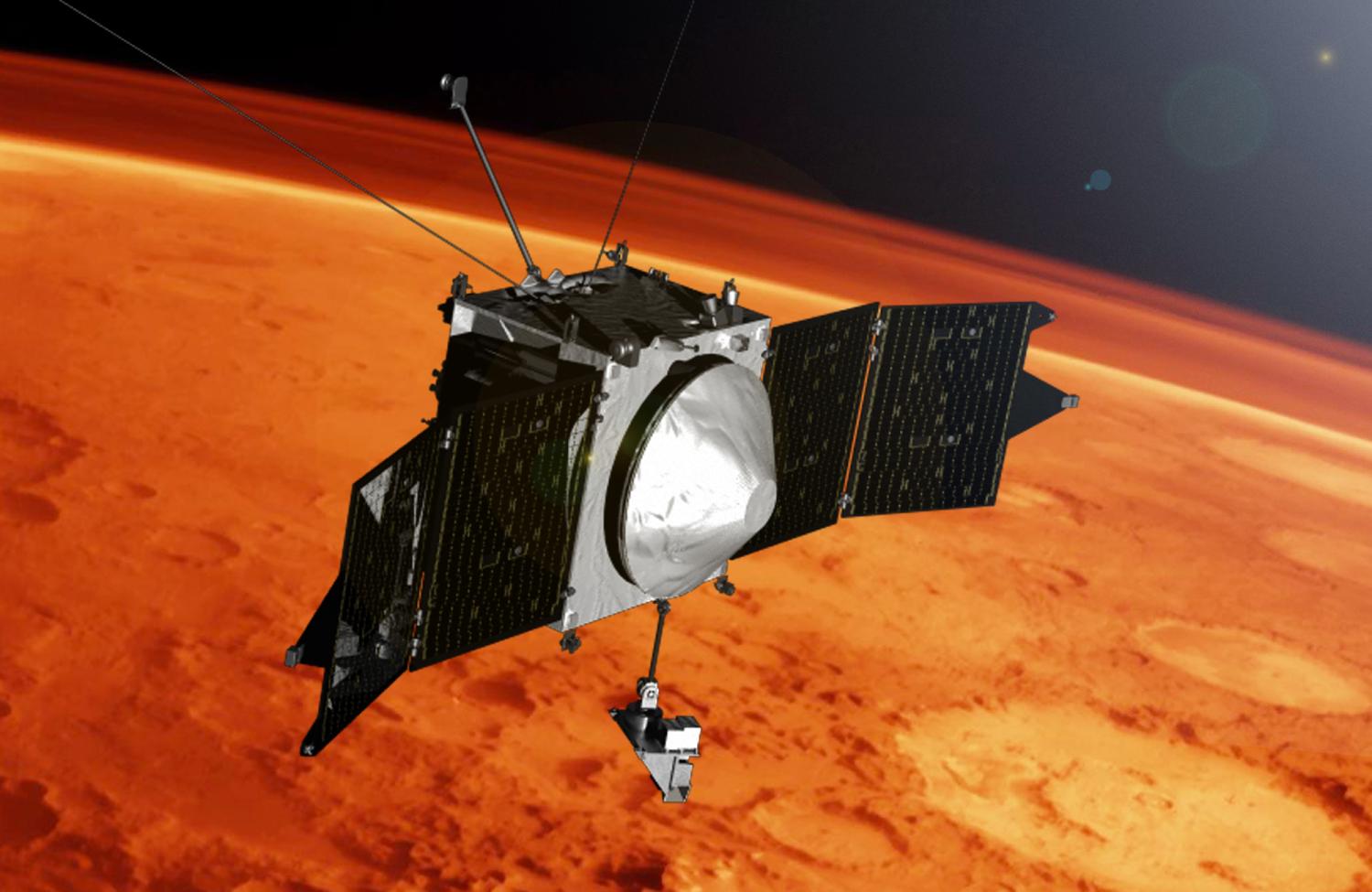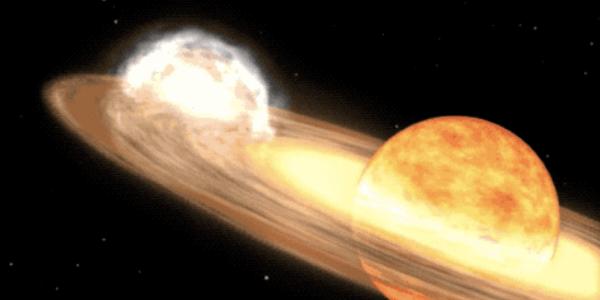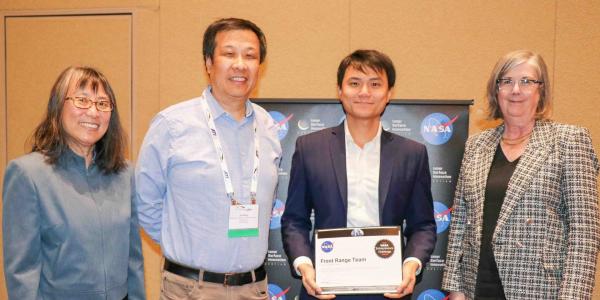In 2023, the Laboratory for Atmospheric and Space Physics (LASP) celebrated its 75th anniversary—marking 75 years of CU Boulder’s exploration of space, from the fringes of Earth’s atmosphere to the wide expanse of interstellar space.
The university is just getting started. In the year ahead, scientists and engineers from across campus will take part in the first U.S. landing on the moon’s south pole, launch several pint-sized satellites into orbit around Earth, and begin a journey to Jupiter’s dark and frigid moon Europa.
Follow along to learn what the next year holds in store for CU Boulder in space.

1. What goes up...
The festivities are scheduled to kick off Oct. 29 as a team from LASP launches a first-of-its-kind instrument in space from the White Sands Missile Range in New Mexico—to investigate the fallout from an explosion that roiled a corner of the galaxy roughly 15,000 years ago.
The launch is part of the Integral Field Ultraviolet Spectroscopic Experiment (INFUSE). The mission will shoot a rocket to about 250 miles above Earth’s surface, where it will point its instrument up into space, before falling back to Earth.
INFUSE is trying to learn more about the structure of the Cygnus Loop supernova remnant, a shock wave that was formed millennia ago as a star died in the constellation Cygnus the Swan.
And don’t miss these other upcoming missions that include scientists and engineers from LASP: SNIFS, EXIS and TSIS-2 will probe the sun and its radiation, while GOES-U will monitor weather on Earth and in space.
Image: Cygnus Loop (Credit: NASA/JPL-Caltech)

2. Historic return
Well, hello, moon. Long time no see. CU Boulder researchers will soon take part in an effort to land science payloads from the United States on the lunar surface for the first time since the Apollo era.
The event is part of NASA’s inaugural Commercial Lunar Payload Services (CLPS) mission. On Nov. 15, a NOVA-C lander built by the company Intuitive Machines is scheduled to launch for the moon’s south pole. Aboard will be an instrument called Radio wave Observations at the Lunar Surface of the photoElectron Sheath (ROLSES). ROLSES, made up of four antennas, will map out the layer of charged particles that hovers just about the surface of the moon—and could pose risks to future lunar astronauts.
“We are going to the surface of the moon for the first time in over 50 years,” said Jack Burns, a co-investigator on the instrument and professor emeritus in the Department of Astrophysical and Planetary Sciences.
Image: Moon's south pole (Credit: NASA/JPL-Caltech)

3. Happy birthday, MAVEN
A special spacecraft is celebrating a big birthday this year. Nov. 18 marks the 10th anniversary of the 2013 launch of NASA’s Mars Atmosphere and Volatile EvolutioN (MAVEN) mission. Several of the instruments on the spacecraft were designed and built by scientists and engineers in Boulder at LASP.
MAVEN is helping to solve a Red Planet mystery: How did Mars, which was likely covered in oceans billions of years ago, lose all of its water? Data from the spacecraft revealed that radiation from the sun stripped away the planet’s atmosphere over time—transforming it into the cold and desolate landscape it is today.
MAVEN is still orbiting the planet and trying to unlock Mars’ secrets today.
Image: Artist's depiction of MAVEN at Mars. (Credit: NASA/GSFC)

4. Whoosh!
Hear that? A new, high-tech engineering lab is heading for campus—at speeds of nearly Mach 30, or more than 20,000 miles per hour.
In July, the Ann and H.J. Smead Department of Aerospace Engineering Sciences kicked off construction on a new hypersonics research facility. This plasma wind tunnel will allow scientists to recreate what happens to spacecraft when they smack into Earth’s atmosphere at incredible speeds, heating up to temperatures of more than 17,000 degrees Fahrenheit.
The new wind tunnel is the brainchild of Assistant Professor Hisham Ali, and construction should wrap up in 2024. Now that’s fast.
Image: Hisham Ali

5. Shadowy science
In the coming year, two eerie astronomical events are heading for North America: On Oct. 14, 2023, parts of the western U.S. will witness an annular, or “ring of fire,” solar eclipse. Then in April 2024, a total solar eclipse will similarly pass above swaths of Texas, Arkansas and more.
To celebrate these rare, and dark, events, the Fiske Planetarium has launched a series of videos and outreach activities called Science through Shadows. In addition to featuring eclipses, the program will explore the unique physics that scientists can explore during “occultations” and “transits”—or when one celestial body, like a moon or planet, passes in front of another, like a star, briefly blocking out its light. The project is led by Douglas Duncan, professor emeritus of astrophysical and planetary sciences, and John Keller, director of Fiske.
“There is science that can be done during eclipses, occultations and transits,” Keller said. “One technique for discovering planets in other systems is by detecting them as they transit in front of stars."
Image: Annular eclipse in 1992. (Credit: CC photo via Flickr)
6. CubeSats galore
Little satellites. Big science.
In the coming year or more, scientists at CU Boulder are scheduled to launch four CubeSats into space. These petite spacecraft are no bigger than a toaster oven but will collect scientific data that far outstrip their size. They include Climatology of Anthropogenic and Natural VLF wave Activity in Space (CANVAS) led by Robert Marshall, associate professor of aerospace engineering. CANVAS will orbit Earth, tracking the bursts of energy that fly into space when lightning strikes—which happens a whopping 50 times per second on our planet.
Learn more about CANVAS and these other, upcoming CubeSat missions: AEPEX, MAXWELL and SPRITE.
Image: Artist's depiction of the Supernova Remnants and Proxies for ReIonization Testbed Experiment (SPRITE) CubeSat. (Credit: LASP)

7. Flagship launch
In October 2024, Colorado’s big year in space is scheduled to end with a bang—a literal one—as NASA’s Europa Clipper spacecraft blasts off from the Kennedy Space Center in Florida. This flagship mission will carry with it a roughly $50 million instrument called the SUrface Dust Analyzer (SUDA) designed and built at LASP.
They’re going on a long journey: Europa Clipper will travel nearly 2 billion miles to Jupiter and its moon Europa—a body about the size of Earth’s moon where a thick layer of ice surrounds a deep ocean. There, the mission will explore whether Europa harbors conditions that could support living organisms.
It’s a good beginning for CU Boulder’s next 75 years of space exploration.
Image: SUDA in a cleanroom at LASP. (Credit: Glenn Asakawa/CU Boulder)



